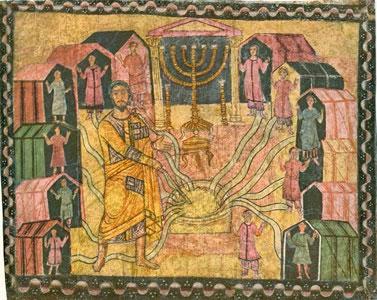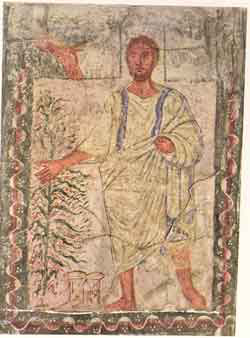What is eau de vie?
In the description of the Children of Israel’s wandering in the desert, several components recur:
- the people complaining about a lack of water and food and their doubts over Moses’ leadership
- Moses appealing to God to resolve the problem
- the Divine supply of water and food
Particularly well known is the story of the taking of water from the rock, which actually appears twice, in Exodus 17 and again in Numbers 20. The version in Numbers is known in particular as providing the reason why Moses was not permitted to enter the land of Israel. Below is the text:
(א) וַיָּבֹ֣אוּ בְנֵֽי־יִ֠שְׂרָאֵ֠ל כׇּל־הָ֨עֵדָ֤ה מִדְבַּר־צִן֙ בַּחֹ֣דֶשׁ הָֽרִאשׁ֔וֹן וַיֵּ֥שֶׁב הָעָ֖ם בְּקָדֵ֑שׁ וַתָּ֤מׇת שָׁם֙ מִרְיָ֔ם וַתִּקָּבֵ֖ר שָֽׁם׃ (ב) וְלֹא־הָ֥יָה מַ֖יִם לָעֵדָ֑ה וַיִּקָּ֣הֲל֔וּ עַל־מֹשֶׁ֖ה וְעַֽל־אַהֲרֹֽן׃ (ג) וַיָּ֥רֶב הָעָ֖ם עִם־מֹשֶׁ֑ה וַיֹּאמְר֣וּ לֵאמֹ֔ר וְל֥וּ גָוַ֛עְנוּ בִּגְוַ֥ע אַחֵ֖ינוּ לִפְנֵ֥י יְהֹוָֽה׃ (ד) וְלָמָ֤ה הֲבֵאתֶם֙ אֶת־קְהַ֣ל יְהֹוָ֔ה אֶל־הַמִּדְבָּ֖ר הַזֶּ֑ה לָמ֣וּת שָׁ֔ם אֲנַ֖חְנוּ וּבְעִירֵֽנוּ׃ (ה) וְלָמָ֤ה הֶֽעֱלִיתֻ֙נוּ֙ מִמִּצְרַ֔יִם לְהָבִ֣יא אֹתָ֔נוּ אֶל־הַמָּק֥וֹם הָרָ֖ע הַזֶּ֑ה לֹ֣א ׀ מְק֣וֹם זֶ֗רַע וּתְאֵנָ֤ה וְגֶ֙פֶן֙ וְרִמּ֔וֹן וּמַ֥יִם אַ֖יִן לִשְׁתּֽוֹת׃ (ו) וַיָּבֹא֩ מֹשֶׁ֨ה וְאַהֲרֹ֜ן מִפְּנֵ֣י הַקָּהָ֗ל אֶל־פֶּ֙תַח֙ אֹ֣הֶל מוֹעֵ֔ד וַֽיִּפְּל֖וּ עַל־פְּנֵיהֶ֑ם וַיֵּרָ֥א כְבוֹד־יְהֹוָ֖ה אֲלֵיהֶֽם׃ {פ} (ז) וַיְדַבֵּ֥ר יְהֹוָ֖ה אֶל־מֹשֶׁ֥ה לֵּאמֹֽר׃ (ח) קַ֣ח אֶת־הַמַּטֶּ֗ה וְהַקְהֵ֤ל אֶת־הָעֵדָה֙ אַתָּה֙ וְאַהֲרֹ֣ן אָחִ֔יךָ וְדִבַּרְתֶּ֧ם אֶל־הַסֶּ֛לַע לְעֵינֵיהֶ֖ם וְנָתַ֣ן מֵימָ֑יו וְהוֹצֵאתָ֨ לָהֶ֥ם מַ֙יִם֙ מִן־הַסֶּ֔לַע וְהִשְׁקִיתָ֥ אֶת־הָעֵדָ֖ה וְאֶת־בְּעִירָֽם׃ (ט) וַיִּקַּ֥ח מֹשֶׁ֛ה אֶת־הַמַּטֶּ֖ה מִלִּפְנֵ֣י יְהֹוָ֑ה כַּאֲשֶׁ֖ר צִוָּֽהוּ׃ (י) וַיַּקְהִ֜לוּ מֹשֶׁ֧ה וְאַהֲרֹ֛ן אֶת־הַקָּהָ֖ל אֶל־פְּנֵ֣י הַסָּ֑לַע וַיֹּ֣אמֶר לָהֶ֗ם שִׁמְעוּ־נָא֙ הַמֹּרִ֔ים הֲמִן־הַסֶּ֣לַע הַזֶּ֔ה נוֹצִ֥יא לָכֶ֖ם מָֽיִם׃ (יא) וַיָּ֨רֶם מֹשֶׁ֜ה אֶת־יָד֗וֹ וַיַּ֧ךְ אֶת־הַסֶּ֛לַע בְּמַטֵּ֖הוּ פַּעֲמָ֑יִם וַיֵּצְאוּ֙ מַ֣יִם רַבִּ֔ים וַתֵּ֥שְׁתְּ הָעֵדָ֖ה וּבְעִירָֽם׃ {ס}
(1) The Israelites arrived in a body at the wilderness of Zin on the first new moon, and the people stayed at Kadesh. Miriam died there and was buried there. (2) The community was without water, and they joined against Moses and Aaron. (3) The people quarreled with Moses, saying, “If only we had perished when our brothers perished at the instance of יהוה ! (4) Why have you brought יהוה’s congregation into this wilderness for us and our beasts to die there? (5) Why did you make us leave Egypt to bring us to this wretched place, a place with no grain or figs or vines or pomegranates? There is not even water to drink!” (6) Moses and Aaron came away from the congregation to the entrance of the Tent of Meeting, and fell on their faces. The Presence of יהוה appeared to them, (7) and יהוה spoke to Moses, saying, (8) “You and your brother Aaron take the rod and assemble the community, and before their very eyes order the rock to yield its water. Thus you shall produce water for them from the rock and provide drink for the congregation and their beasts.” (9) Moses took the rod from before יהוה, as he had been commanded. (10) Moses and Aaron assembled the congregation in front of the rock; and he said to them, “Listen, you rebels, shall we get water for you out of this rock?” (11) And Moses raised his hand and struck the rock twice with his rod. Out came copious water, and the community and their beasts drank.
However, in addition to the account of water flowing from the rock, there are stories about the purification of a spring (Exodus 15:22-25), the discovery of springs (Exodus 15:27) and the digging of a well (Numbers 21:16-20). Although it is possible to understand the recurring stories as a reflection of the harsh reality of desert wandering, the midrashic imagination of the Sages saw in them more than just a chain of separate coincidences and more than a mere logistical problem. This view is reflected in numerous explanations in the midrashim from various periods that seek to link all the events together and to understand them symbolically.
The Miracle of the Water in the Dura Europos Synagogue
Below is a wall painting an ancient synagogue uncovered in 1932 in the city of Dura Europos, Syria. The synagogue there was built and destroyed in the 3rd century CE.

Dura Europos, The Water Miracles in the Desert
A large menorah dominates the center of the painting; below it is an oval structure from which or to which several gray strips lead. Beside the oval structure stands a large figure pointing at it with its two hands. And 12 small figures stand before houses arrayed in an inverted U-shape. When the painting was uncovered, various interpretations were suggested. Based on a comparison of the large figure, dressed in the style of a Hellenist teacher, and other paintings in the synagogue, the figure has been identified as Moses; the 12 small figures, dressed as Persian princes, were identified as the tribal chiefs. In other words, two major cultural influences on Dura Europos are recognizable in these figures: Roman and Persian. What we have here, then, is a painting of the camps of Israel, with the Tabernacle located at the top of the inverted U. Once one discerns that Moses is holding a staff that he inserts into the round structure, it becomes clear that this is a painting of the miracle of the water described in Exodus 15, the sweetening of the bitter waters of Mara.
Strange elements of the painting
But unexplained elements remain:
• The inverted U-shape and the placement of the Tabernacle at its top do not correspond to the description of the camps in the Torah, according to which the Tabernacle stood in the center of the camp, and the 12 tribes surrounded it on four sides in a square.

• The strips linking the spring/well to the homes of the tribes are not mentioned in the Bible at all.

• Neither the relationship between the spring/well and the Tabernacle nor the placement of the Tabernacle’s vessels (the menorah, the two altars for incense and the table of the shewbread) have been explained adequately

As for the Tabernacle, a look at Numbers 20:6f. clarifies that at least in this story, there is indeed a close connection between the Tent of Meeting, i.e., the Tabernacle and the rock from which the water emerged. In addition, it appears that there is a connection between the twelve princes/tribal encampments and the twelve springs in Exodus 15:27. And the oval structure appears to be the mouth of a well, in accordance with Numbers 21. Therefore, it seems that our painting relates to some sort of combination of all the water miracles in the Torah.
But the meaning of the strips is still unclear.
The Mystery of the Paths
Since it is known that rabbinic midrashim underlie many of the Dura Europos synagogue paintings, scholars searched sources that discuss the water miracles that occurred in the desert, in order to solve these mysteries.
Tosefta Sukka features a description of the well which is also a rock filled with compartments that spurt water out of all of its openings. The well wanders with the children of Israel and halts at every stop opposite the Tabernacle.
Targum Yonatan, which contains extensive midrashic material, adds to the text in Numbers 21 that Miriam’s well wandered with the children of Israel throughout their journey and its waters flowed to the entrance of the tent of each and every one of the children of Israel.
And in the book Biblical Antiquities (11:14), a composition dating to the Second Temple era, there is a midrash that deals with the water crisis at Mara, which occurred at the beginning of the period of wandering (Exodus 15). In this composition too, the well travels with the nation, but here Moses sweetens its waters using the Tree of Life, identified as a metaphor for the Torah. This identification, also found in Proverbs 3:18 (“she is a tree of life”), is based on the unique wording of the text in Exodus:
(כה) וַיִּצְעַ֣ק אֶל־יהוה וַיּוֹרֵ֤הוּ יהוה עֵ֔ץ וַיַּשְׁלֵךְ֙ אֶל־הַמַּ֔יִם וַֽיִּמְתְּק֖וּ הַמָּ֑יִם שָׁ֣ם שָׂ֥ם ל֛וֹ חֹ֥ק וּמִשְׁפָּ֖ט וְשָׁ֥ם נִסָּֽהוּ׃
Note the use of the Hebrew word, vayoruhu, 'and the Lord showed/taught him.'
It seems that according to the midrashim, the rock, the well and the spring are none other than symbols or metaphors for one thing – the Torah.
The source of fresh water [i.e., the Torah] traveled with the Children of Israel for 40 years and stood opposite the entrance to the Tabernacle at every camp and disappeared when they were idle from Torah study (Targum Yonatan).
The Significance of the Pictures Structure
Now let us again consider the painting from Dura Europos, here shown only with the basic structure of the camp. Next to the painting from Dura Europos is a medieval depiction of the layout of the Israelites camp. As in the painting from Dura Europos, tents are used to portray the tribes encamped around the Tabernacle.

The two depictions are almost identical. But in the later painting, the tents are arranged in a square and the Tabernacle is in the middle. In the Dura Europos painting, the artist drew in the middle the contents of the Tabernacle: the well-rock-spring = the Torah as well as the Tabernacle vessels. In order to display these objects, he had to open the bottom side of the square and move the Tabernacle to the upper edge.
Thus, the Dura Europos painting is more than just an illustration of a passage from the Torah. Using the midrashic imagination, the artist is teaching the role of the Torah as the most basic need, the source of living water and the guide of the People of Israel, for his own time just as for the generation of the Desert wandering, in a world full of difficulties and uncertainties.
For additional images on this subject see TALI Visual Midrash



